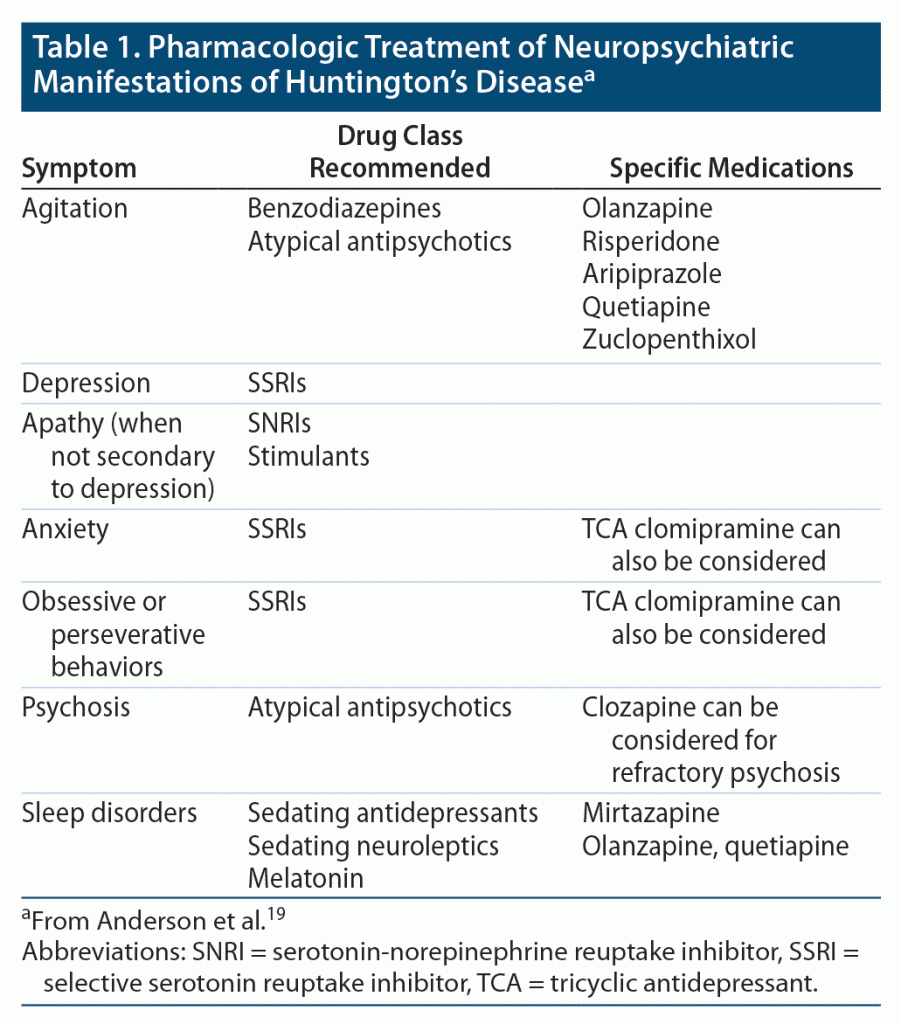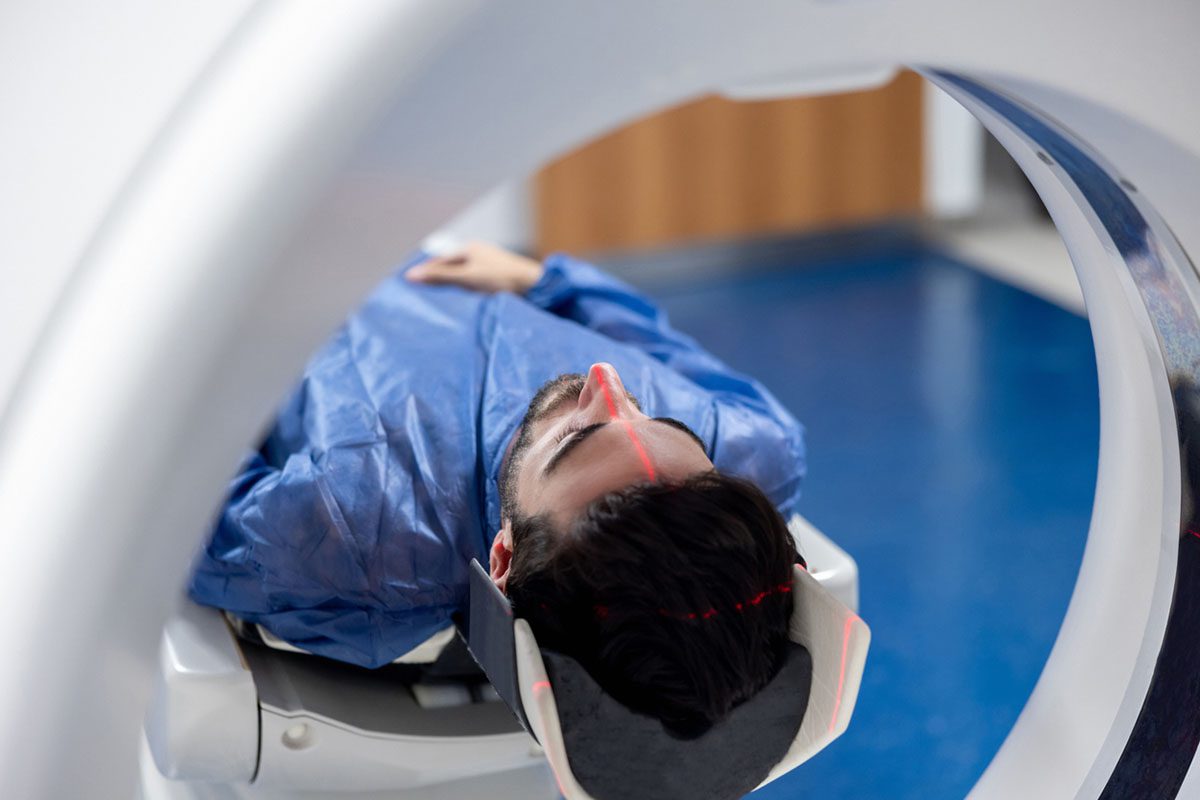
Prim Care Companion CNS Disord 2023;25(1):22cr03265
To cite: Jay JA, Kumar V, Garrels E, et al. Management of neuropsychiatric disturbances in Huntington’s disease: a literature review and case report. Prim Care Companion CNS Disord. 2023;25(1):22cr03265.
To share: https://doi.org/10.4088/PCC.22cr03265
© 2023 Physicians Postgraduate Press, Inc.
aDepartment of Psychiatry, BronxCare Health System, Bronx, New York
*Corresponding author: Joshua A. Jay, MD, 1276 Fulton Ave, Bronx, NY 10456 ([email protected]).
Huntington’s disease (HD) is an inherited autosomal dominant neurodegenerative condition caused by the trinucleotide CAG (cytosine, adenine, guanine) repeat expansion in the Huntington (HTT) gene.1 The resulting HTT protein causes dysfunction and death of neurons, with a full penetrance of HD resulting from more than 40 CAG repeats, and a partial penetrance can be seen between 36 and 39 CAG repeats.2,3 Prevalence in the western population ranges from 10.6–13.7 per 100,000 individuals.2,4 HD is characterized by a range of motor (chorea, dystonia, bradykinesia, oculomotor dysfunction), cognitive, and psychiatric symptoms, the latter of which usually manifest prior to the onset of motor or cognitive disturbances.5–7 Psychiatric problems in HD are a major cause of hospitalizations and substantially impact day-to-day functioning, leading to significant distress in the individual and family members.5 These disturbances include affective disorders, psychosis, and neuropsychiatric symptoms such as apathy and irritability.8,9 Changes in personality are the most common behavioral manifestations, followed by depression, which has a lifetime prevalence of around 39% among these patients.10 Schizophrenia-like psychosis is seen in roughly 1%–25% of cases, with higher risk in those who develop early onset HD.11,12 In addition to the psychiatric and cognitive issues, a US claims database analysis13 also highlighted the prevalence of communication, mobility, and swallowing problems in HD patients, indicating the need for a holistic approach to care. Literature available on treating psychosis and other behavioral issues in HD is scarce.
Case Report
A 54-year-old man with an unclear psychiatric history as well as a medical history of newly diagnosed HD was brought to the medical emergency department due to agitation and disorganized behavior at his shelter. He was admitted to the inpatient psychiatry unit for further management of his behavioral symptoms. During admission, staff from his shelter provided contact details for his sister who was able to provide more detailed collateral information. His sister reported that he was recently diagnosed with HD and revealed a family history of HD in their brother who died from the disease. She also reported that the patient had no past psychiatric history or admissions to a psychiatric unit. He did not express suicidal or homicidal ideation but exhibited worsening of mood and aggression for the past few months since his diagnosis. Social history of the patient revealed that he was unemployed and living in a shelter. His sister, who lived across the country, was the only family member with whom he was in contact. Social supports were extremely limited. The patient reported smoking 3 cigarettes daily. He denied any other substance use, illicit or otherwise. His medical history, per records obtained from an outpatient neurology clinic, revealed genetic confirmation for diagnosis of HD.
At evaluation, the patient appeared internally preoccupied and was observed laughing inappropriately to himself. He presented with disorganized thought process, aggressive behavior, and auditory hallucinations. He endorsed auditory hallucinations stating, “I am hearing rap music.” He stated that the police had brought him to the hospital “for no reason.” He denied any psychiatric history. The patient denied having done anything out of the ordinary at his shelter; however, due to his disorganized thought process, his history was unreliable, and he was unable to provide further details. During the admission, he endorsed grandiose delusions such as “I am a writer, I am writing a book on police work,” “I am an athlete,” “I am very strong,” and “I can run marathons.” He would ruminate on the idea of writing a book and mention this repeatedly to any questions asked to him. He would often fixate on certain topics and perseverate. The patient had visible choreoathetoid movements that affected his gait, though he was able to ambulate. He was not bothered by their presence. When questioned on his apparent indifference he would reply, “What movements?” He was noted to be apathetic with poor insight into his conditions. The team attempted to send the patient for brain imaging, but it was not feasible due to his level of agitation and unwillingness to cooperate with the procedure through repeated refusals.
During the admission, a telemedicine appointment with a neurologist was organized for HD recommendations. The neurologist recommended that the patient would benefit from tetrabenazine to decrease involuntary choreoathetoid movements, which was followed. At times, the patient would become agitated to the point of requiring emergent intramuscular medication for safety. Other times, he kept to himself and remained isolated in his room. To manage his psychotic and mood symptoms, he was initiated on an atypical antipsychotic. He was selectively compliant, but he eventually agreed to receive a dose of a long-acting injectable formulation of the antipsychotic.
Two incidences of skin picking were noted during the admission. The first occurred after his beard grew out. He stated, “There’s bed bugs in my beard” and continuously scratched the same area of his neck. He developed redness and irritation in the area. He stopped scratching after receiving a shave. The second incidence occurred when the patient showed us his elbow was bleeding. When asked how it happened, he stated, “I don’t know.” He received wound care. The next day he had 2 new wounds in the same area, similar to the initial one, and it was noted that he was scratching that same area. Upon inspection, he had many light scars across his forearms bilaterally, likely due to similar compulsive scratching. It was postulated that in addition to psychosis, the patient may have had obsessive-compulsive behavior secondary to HD. The team attempted to start him on a selective serotonin reuptake inhibitor (SSRI) to address these behaviors, but he did not tolerate the medication stating it gave him headaches.
Neurocognitive deficits secondary to HD were also noted. Initially, the patient had difficulty participating in cognitive testing or any rating scales but was eventually able to complete a Montreal Cognitive Assessment,14 on which he scored 18/30. The most significant deficits were noted in domains of visuospatial/executive, attention, language, abstraction, and delayed recall.
The patient ultimately required long-term specialized care and was discharged to a facility that cares solely for patients with HD. There were significant barriers to admission to the facility, however, due to insurance issues that required appeals and multiple meetings. Specifically, an appropriate specialized facility was identified relatively early in the patient’s hospitalization, but as it was considered “out of network” by his insurance provider, they initially declined to cover his stay there, and the hospital had to prove that there was no “in-network” facility that could provide the patient adequate care. Although it was quickly apparent to the treatment team that this was the case as there are very few such specialized facilities, resolving the issue became a lengthy process, resulting in a prolonged hospital stay for the patient. His sister and case worker provided ample support and collaboration to mediate the process.
Discussion
HD is a condition that causes severe neuronal dysfunction and death, leading to progressive atrophy of the caudate and putamen, the cause of which is heavily tied to excessive CAG repeats. While the full extent of the damage caused by CAG repeats is yet to be realized, some of the discovered effects leading to neuronal dysfunction include (1) CAG aggregate formation leading to insoluble, toxic inclusions; (2) transcriptional dysregulation of brain-derived neurotrophic factor; (3) altered protein homeostasis and proteasome dysfunction; (4) mitochondrial dysfunction; (5) altered synaptic plasticity such as excitotoxicity of N-methyl-D-aspartate receptors; (6) defects in axonal transport; and (7) neuroglia dysfunction.15 The age at onset of this condition is greatly tied to its penetrance. HD is partially penetrant (variable age at onset) between 36 and 39 CAG repeats with a full penetrance (early onset) at 40 or more.5,10 There is an inverse correlation between number of CAG repeats and age at onset, such that the more CAG repeats that are present in the individual, the earlier the onset of the disease. This phenomenon is called anticipation.
Literature is scarce regarding the management of neuropsychiatric manifestations of HD; however, some studies have been done. As behavioral symptoms have an impact on quality of life, The Movement Disorder Society commissioned the assessment of the clinimetric properties of rating scales in HD.16 The main challenges identified for assessment of behavioral symptoms in HD are the co-occurrence of multiple behavioral symptoms, the features of a behavioral symptom in HD, and the need to address stage- and disease-specific features, including cognitive impairment and lack of insight. Three rating scales were classified as recommended exclusively for screening purposes: the Irritability Scale for irritability16 and the Beck Depression Inventory-II17 and the Hospital Anxiety and Depression Scale for depression.18
The Journal of Huntington’s Disease published an article in 2018 by Anderson et al19 that outlines expert-based consensus guidelines for neuropsychiatric symptoms of HD. For agitation, once medical comorbidities have been ruled out and verbal redirection attempted, benzodiazepines or antipsychotics are the best choice (Table 1). Studies have shown that atypical antipsychotics are preferred over typical due to less potential to worsen movement symptoms.20 Olanzapine, risperidone, aripiprazole, and quetiapine have all been used effectively, when given as standing medications.20 Olanzapine can be used intramuscularly. One case report notes sustained improvement with the use of the antipsychotic zuclopenthixol; however, this medication is not approved in the United States.20 For apathy and depression, clinical distinction must be made between apathy caused by HD versus that caused by depression. In depressed individuals, SSRIs are the mainstay treatment. However, in cases of HD-induced apathy in the nondepressed individual, a serotonin-norepinephrine reuptake inhibitor (SNRI), another activating antidepressant, or a stimulant may be used with caution (see Table 1).2 There is no consensus regarding specific medications within these classes for treatment of depression. A Danish study21 using data from national death certificates revealed that in cases of HD as an underlying cause of death, 5.6% had committed suicide compared to 2.7% in the general population, thus noting suicide was more common among individuals with HD compared to the general population.
In a German claims data study by Ohlmeier et al in 2019,22 the most frequently observed comorbidities and disease-associated symptoms in HD patients were depression (42.9%), dementia (37.7%), urinary incontinence (32.5%), extrapyramidal and movement disorders (30.5%), dysphagia (28.6%), and disorders of the lipoprotein metabolism (28.2%). The most common medications in HD patients were antipsychotics (66.9%) followed by antidepressants (45.1%). Anticonvulsants (16.6%), opioids (14.6%), and hypnotics (9.7%) were observed less frequently.
In patients with HD with anxiety and/or obsessive perseverative behaviors, SSRIs can be used19 as well as the tricyclic antidepressant clomipramine.23 For psychosis in HD, antipsychotic medications are recommended, with 83% of clinicians preferring atypical antipsychotics. Caution must be exercised as to not exceed maximum dosing and to not combine multiple antipsychotics. Clozapine can be used in the case of refractory symptoms that cannot be controlled with other antipsychotics.19 Majothi et al24 notes that clozapine should be prescribed for psychosis in HD under the same guidelines as for schizophrenia in cases when 2 or more antipsychotic trials have failed to control psychosis. In some cases, cognitive impairment can precede the onset of other symptoms of HD by many years.2 There does not seem to be a consensus regarding proper pharmacologic treatment of impaired cognition in the context of HD.2 The presence of cognitive decline is a predictive factor for placement of HD patients into long-term care.2 Cognitive decline also seems to be a factor in the placement of HD patients into nursing facilities, which may not be an ideal therapeutic setting if staff is not specifically trained to manage HD.
In our 54-year-old patient with HD, the presenting symptoms were psychosis, worsening mood, aggression, and obsessive behaviors of skin picking and scratching. All these symptoms were treated within the consensus guidelines recommended by Anderson et al.19 His psychotic symptoms were successfully managed with an atypical antipsychotic. The team attempted to manage his poor mood as well as his obsessive skin picking with an SSRI, which was ultimately discontinued due to poor tolerability and side effects. SNRIs were not recommended in this case due to his irritability and aggression at admission.
In the United States, approximately 50% of health care costs are covered by employers’ insurance, 30% by government-run programs, and 5% by individually purchased insurance. The remaining 15% are left with no health insurance coverage, revealing a large gap in care for these patients.25 Individuals with HD or at risk of HD have reported fear of being discriminated against by insurance companies and employers due to the high burden of their condition.26 Although the Genetic Information Nondiscrimination Act27 prohibits such discrimination, it does not prevent insurance providers from rejecting applications for individuals with chronic illness or charging them with higher rates.28 Divino et al29 quantified the economic burden and major cost drivers in HD patients based on the stages of disease (early/middle/late) using an assessment of markers related to disease severity and compared those costs in commercial (non–government-provided insurance) and Medicaid (government-provided insurance) claims. They discovered that not only did more late-stage HD Medicaid patients require nursing home care (73.8%) compared to their commercial counterparts (40.6%), but also the median annual cost per patient was higher in Medicaid patients ($35,925) versus commercial patients ($12,618).29 Most individuals with HD will begin to show symptoms in their fourth or fifth decades of life,30 and while Medicare, Medicaid, and private insurances may cover some HD care–related costs, they do not cover all of it. Due to the lengthy course of disease (15–20 years), individuals require extended health and social care services.31 Ohlmeier et al22 reported that physical therapy was the most often used medical aid in HD patients (46.4%). Nursing services and speech therapy were used by 27.9% and 22.7% of HD patients, respectively, whereas use of psychotherapy was rare (3.2%).22
The bill for Huntington’s Disease Disability Insurance Access Act of 202132 was recently introduced in the US Senate on March 18, 2021. If passed, the bill would eliminate the 5-month waiting period for social security disability insurance benefits for individuals with HD and the additional 24-month waiting period to become eligible for Medicare. Support for such reforms is important in providing safe and effective management of neuropsychiatric symptoms in a multidisciplinary manner.
Conclusion
HD can cause severe neuropsychiatric symptoms including agitation, psychosis, mood dysregulation, and cognitive decline. These symptoms get worse as the disease progresses. Proper assessment and understanding of such patients are critical in providing appropriate treatment and determining the appropriate setting for their care. Future studies should investigate the role of other factors in determining neuropsychiatric symptoms in HD and its management.
Published online: January 26, 2023.
Relevant financial relationships: None.
Funding/support: None.
Previous presentation: Previously presented as a poster at BronxCare Hospital Day; December 11, 2021; Bronx, New York.
Patient consent: Verbal consent was obtained from the patient to publish the case report, and information has been de-identified to protect anonymity.
References (32)

- The Huntington’s Disease Collaborative Research Group. A novel gene containing a trinucleotide repeat that is expanded and unstable on Huntington’s disease chromosomes. Cell. 1993;72(6):971–983. PubMed CrossRef
- McColgan P, Tabrizi SJ. Huntington’s disease: a clinical review. Eur J Neurol. 2018;25(1):24–34. PubMed CrossRef
- Nance MA. Genetics of Huntington disease. Handb Clin Neurol. 2017;144:3–14. PubMed CrossRef
- Yohrling G, Raimundo K, Crowell V, et al. Prevalence of Huntington’s disease in the US (954). Neurol. 2020;94(suppl 15):954.
- Paoli RA, Botturi A, Ciammola A, et al. Neuropsychiatric burden in Huntington’s disease. Brain Sci. 2017;7(6):67. PubMed CrossRef
- McAllister B, Gusella JF, Landwehrmeyer GB, et al. Timing and impact of psychiatric, cognitive and motor abnormalities in Huntington disease. Neurology. 2021 May 11;96(19):e2395-e2406. PubMed CrossRef >
- Julien CL, Thompson JC, Wild S, et al. Psychiatric disorders in preclinical Huntington’s disease. J Neurol Neurosurg Psychiatry. 2007;78(9):939–943. PubMed CrossRef
- Dewhurst K, Oliver JE, McKnight AL. Socio-psychiatric consequences of Huntington’s disease. Br J Psychiatry. 1970;116(532):255–258. PubMed CrossRef
- Bolt JM. Huntington’s chorea in the West of Scotland. Br J Psychiatry. 1970;116(532):259–270. PubMed CrossRef
- Watt DC, Seller A. A clinico-genetic study of psychiatric disorder in Huntington’s chorea. Psychol Med. 1993;23(suppl 23):1–46. PubMed CrossRef
- Taylor D, Paton C, Kapur S. The Maudsley Prescribing Guidelines in Psychiatry. 13th ed. Oxford: Wiley Blackwell; 2018.
- Corrêa BB, Xavier M, Guimarães J. Association of Huntington’s disease and schizophrenia-like psychosis in a Huntington’s disease pedigree. Clin Pract Epidemiol Ment Health. 2006;2(1):1. PubMed CrossRef
- Ishihara L, Oliveri D, Wild EJ. Neuropsychiatric comorbidities in Huntington’s and Parkinson’s disease: a United States claims database analysis. Ann Clin Transl Neurol. 2021;8(1):126–137. PubMed CrossRef
- Nasreddine ZS, Phillips NA, Bédirian V, et al. The Montreal Cognitive Assessment, MoCA: a brief screening tool for mild cognitive impairment. J Am Geriatr Soc. 2005;53(4):695–699. PubMed CrossRef
- Jimenez-Sanchez M, Licitra F, Underwood BR, et al. Huntington’s disease: mechanisms of pathogenesis and therapeutic strategies. Cold Spring Harb Perspect Med. 2017;7(7):a024240. PubMed CrossRef
- Mestre TA, van Duijn E, Davis AM, et al; Members of the MDS Committee on Rating Scales Development. Rating scales for behavioral symptoms in Huntington’s disease: critique and recommendations. Mov Disord. 2016;31(10):1466–1478. PubMed CrossRef
- Beck AT, Steer RA, Brown G. Beck Depression Inventory–II (BDI-II). APA PsycTests; 1996. [Database record], 10.1037/t00742-000.
- Zigmond AS, Snaith RP. The Hospital Anxiety and Depression Scale. Acta Psychiatr Scand. 1983;67(6):361–370. PubMed CrossRef
- Anderson KE, van Duijn E, Craufurd D, et al. Clinical management of neuropsychiatric symptoms of Huntington’s disease: expert-based consensus guidelines on agitation, anxiety, apathy, psychosis and sleep disorders. J Huntingtons Dis. 2018;7(3):355–366. PubMed CrossRef
- Rossi G, Oh JC. Management of agitation in Huntington’s disease: a review of the literature. Cureus. 2020;12(8):e9748. PubMed CrossRef
- Sørensen SA, Fenger K. Causes of death in patients with Huntington’s disease and in unaffected first degree relatives. J Med Genet. 1992;29(12):911–914. PubMed CrossRef
- Ohlmeier C, Saum KU, Galetzka W, et al. Epidemiology and health care utilization of patients suffering from Huntington’s disease in Germany: real world evidence based on German claims data. BMC Neurol. 2019;19(1):318. PubMed CrossRef
- Oosterloo M, Craufurd D, Nijsten H, et al. Obsessive-compulsive and perseverative behaviors in Huntington’s disease. J Huntingtons Dis. 2019;8(1):1–7. PubMed CrossRef
- Majothi N, Lee H, Nagarajan P, et al. Treatment of psychosis in Huntington’s disease with clozapine. Prog Neurol Psychiatry. 2020;24(2):14–16. CrossRef
- Nuwer MR, Esper GJ, Donofrio PD, et al. The US health care system, part 1: our current system. Neurology. 2008;71(23):1907–1913. PubMed CrossRef
- Oster E, Dorsey ER, Bausch J, et al; Huntington Study Group PHAROS Investigators. Fear of health insurance loss among individuals at risk for Huntington disease. Am J Med Genet A. 2008;146A(16):2070–2077. PubMed CrossRef
- The White House. President Bush Signs H.R. 493, the Genetic Information Nondiscrimination Act of 2008. 2008. Accessed November 11, 2021. https://www.eeoc.gov/statutes/genetic-information-nondiscrimination-act-2008 >
- Erwin C. Legal update: living with the Genetic Information Nondiscrimination Act. Genet Med. 2008;10(12):869–873. PubMed CrossRef
- Divino V, Dekoven M, Warner JH, et al. The direct medical costs of Huntington’s disease by stage: a retrospective commercial and Medicaid claims data analysis. J Med Econ. 2013;16(8):1043–1050. PubMed CrossRef
- Bates G, Harper P, Jones L. Huntington’s Disease. 3rd ed. Oxford: Oxford University Press; 2002.
- Skirton H, Williams JK, Jackson Barnette J, et al. Huntington disease: families’ experiences of healthcare services. J Adv Nurs. 2010;66(3):500–510. PubMed CrossRef
- S.868 - Huntington’s Disease Disability Insurance Access Act of 2021: 117th Congress (2021–2022). Accessed November 11, 2021. https://www.congress.gov/bill/117th-congress/senate-bill/868/text
Please sign in or purchase this PDF for $40.
Save
Cite




